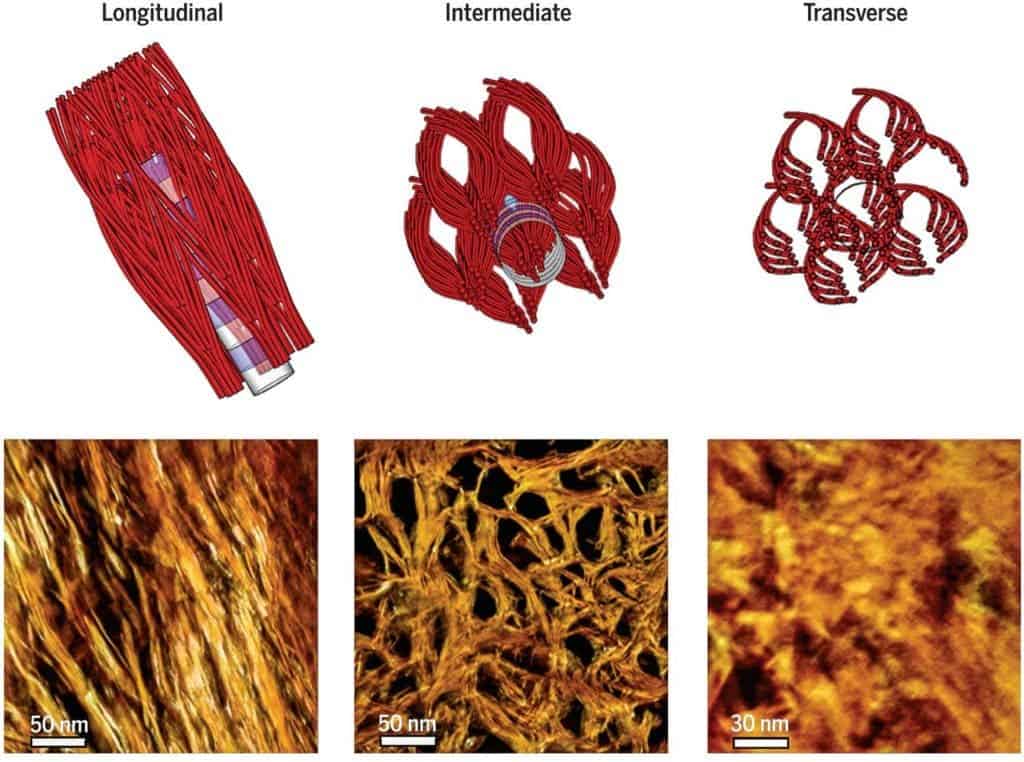뼈가 단단한 이유가 무엇일까?


Bones have a fractal-like structure making them super strong and flexible

Researchers from the University of York and the Imperial College London have produced a 3D, nanoscale reconstruction of bone’s mineral structure. Their work reveals a surprising ‘hierarchical organisation’ which underpins the material’s mechanical versatility.
Bred in the bones
Bone is a surprisingly versatile material. Different varieties of bone can be both strong and flexible, maintaining the lithe form of cheetas, the impressive bulk of elephants, or the lightweight frames of birds alike.
These enviable properties are owed to a sophisticated internal structure. However, the exact nature of this structure and of the interactions between the main components of bone — collagen protein strands and the mineral hydroxyapatite — has so far been unknown. According to new research, however, the ‘hierarchical organization’ of bone is based on small elements coming together to form larger and larger structures.
Their results have shown that individual mineral crystals inside bone tissue come together into larger, more complex structures — ones that come together into even more complex levels of organization, the team reports.
For the findings, the team used advanced 3D nanoscale imaging of the mineral component of human bone. They used a combination of electron microscopy-based techniques to reveal its main mineral building blocks. These nanometer-sized crystals of apatite take on a curved, needle-like shape and merge together into larger, twisted platelets that resemble the shape of propeller blades.
These blades, in turn, merge together and split apart throughout the protein phase of the bone. This overarching weaving pattern of mineral and protein is what provides the material’s strength and flexibility.
“Bone is an intriguing composite of essentially two materials, the flexible protein collagen and the hard mineral called apatite,” Lead author, Associate Professor Roland Kröger, says Associate Professor the University of York’s Department of Physics, lead author of the paper.
“The combination of the two materials in a hierarchical manner provides bone with mechanical properties that are superior to those of its individual components alone and we find that there are 12 levels of hierarchy in bone.”
The paper describes the structure as “fractal-like”, containing 12 different levels of complexity. The needle-like crystals merge into the propeller-like platelets in a roughly parallel arrangement with gaps of roughly 2 nanometers between them. These stacks of platelets, along with some single platelets and acicular crystals, come together into larger “polycrystalline aggregates”. These latter ones are larger laterally than the collagen fibers, and can even span several adjacent fibers — providing a continuous, cross-fiber mineral structure that lends resilience to the bone.

The model of crystal organization in bone proposed by the team.
Patterns specified by the model at the top alongside the mineral organization in different directions (bottom).
Image credits N. Reznikov et al., 2018, Science.
These nanostructures woven into the bone also show a slight curvature, twisting the overall geometry, the team further reports. For example, the individual crystals are curved, the protein (collagen) strands are braided together, mineralized collagen fibrils twist, and the bone themselves have a twist (such as a curvature of a rib).
The team concludes that this fractal-like structure they discovered embedded in our bones is one of the cornerstones of their remarkable physical properties.
The paper “Fractal-like hierarchical organization of bone begins at the nanoscale” has been published in the journal Science.
가볍지만 튼튼하다. 힘을 가해도 잘 휘지 않고 수십~수백 kg의 무게도 잘 버틴다. 게다가 견고해서 충격에도 쉽게 파손되지 않는다. 신소재 이야기가 아니다. 사람과 동물의 뼈 이야기다. 최근 뼈가 강한 이유가 과학적으로 밝혀졌다. 칼슘 등 광물질이 단백질과 긴 섬유 형태를 이룬 채 서로 엉겨 복잡한 거품 모양의 구조를 이루는 게 비결이었다.
나탈리 레즈니코프 영국 임페리얼칼리지런던 재료학과 연구원팀은 전자현미경을 이용해 뼈의 내부 구조를 나노미터(nm, 10억 분의 1m) 단위까지 정밀하게 분석하는 데 처음 성공해 사이언스 4일자에 발표했다.
연구팀은 2차원 이미지를 얻을 수 있는 전자현미경을 이용해 뼈를 각기 다른 각도로 반복 촬영했다. 그 뒤 이 이미지를 재구성해 나노미터 단위의 구조를 알 수 있는 3차원 이미지를 완성했다. 그 결과 이전에는 보이지 않던 미세구조를 확인할 수 있었다.
우선, 뼈를 이루는 기본 ‘단위’는 콜라겐 등 단백질로 된 섬유와, 칼슘 등 광물질로 된 길고 뾰족한 바늘이라는 사실을 알아냈다. 광물질 바늘은 서로 평행하게 모인 뒤 뭉쳐 마치 그물 모양의 구조를 이룬 뒤, 콜라겐 섬유를 둘러싸 굵기가 약 100nm인 긴 밧줄 모양을 만들었다. 이 ‘밧줄’은 다시 서로 평행하게 뭉쳐 마이크로미터 단위의 굵고 긴 섬유가 되고, 이 섬유가 다시 마치 가래떡을 상자에 쌓을 때처럼 차곡차곡 밀집해 단단한 뼈를 구성했다.
연구팀은 “긴 섬유 또는 바늘 모양이 서로 겹치고 꼬이는 구조가 나노 단위부터 거시적 규모까지 반복되고 있다”며 “같은 형태가 크기 별로 반복되는 프랙털 구조”라고 말했다.
📝📷 Story & image Source : 동아사이언스
http://dongascience.donga.com/news.php?idx=22325
http://dongascience.donga.com/news.php?idx=22325
Comments